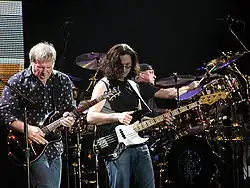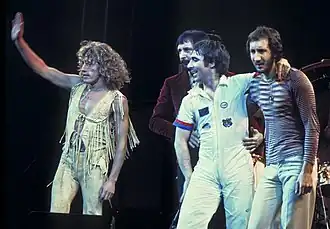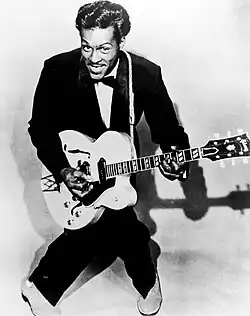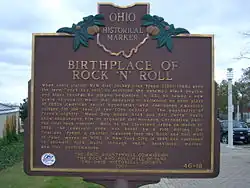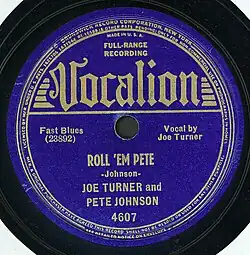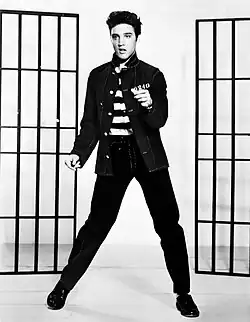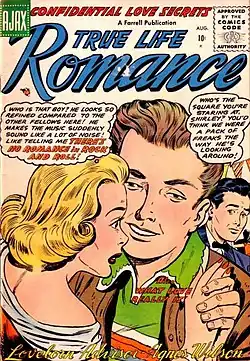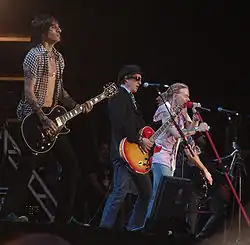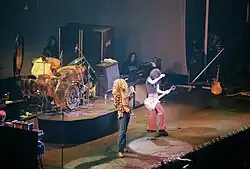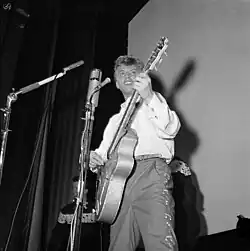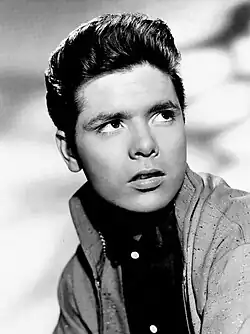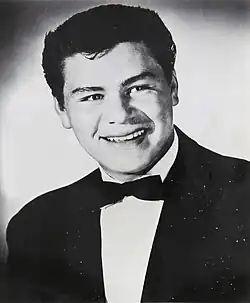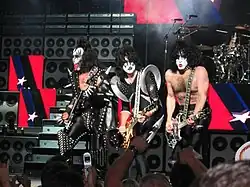Portal:Rock music
The Rock Music Portal
Rock music is a genre of popular music that originated in the United States as "rock and roll" in the late 1940s and early 1950s, developing into a range of styles from the mid-1960s, primarily in the United States and United Kingdom. It has its roots in rock and roll, a style that drew from the black musical genres of blues and rhythm and blues, as well as from country music. Rock also drew strongly from genres such as electric blues and folk, and incorporated influences from jazz and other styles. Rock is typically centered on the electric guitar, usually as part of a rock group with electric bass guitar, drums, and one or more singers.
Usually, rock is song-based music with a 4
4 time signature and using a verse–chorus form; however, the genre has become extremely diverse. Like pop music, lyrics often stress romantic love but also address a wide variety of other themes that are frequently social or political. Rock was the most popular genre of music in the U.S. and much of the Western world from the 1950s up to the 2010s.
Rock musicians in the mid-1960s began to advance the album ahead of the single as the dominant form of recorded music expression and consumption, with the Beatles at the forefront of this development. Their contributions lent the genre a cultural legitimacy in the mainstream and initiated a rock-informed album era in the music industry for the next several decades. By the late 1960s "classic rock" period, a few distinct rock music subgenres had emerged, including hybrids like blues rock, folk rock, country rock, Southern rock, raga rock, and jazz rock, which contributed to the development of psychedelic rock, influenced by the countercultural psychedelic and hippie scene. New genres that emerged included progressive rock, which extended artistic elements, heavy metal, which emphasized an aggressive thick sound, and glam rock, which highlighted showmanship and visual style. In the second half of the 1970s, punk rock reacted by producing stripped-down, energetic social and political critiques. Punk was an influence in the 1980s on new wave, post-punk and eventually alternative rock. (Full article...)
General images -
Selected article

The band spent its first four years signed to the independent record label Fat Wreck Chords, on which they released two studio albums, The Unraveling (2001) and Revolutions per Minute (2003). Both the albums were met with underground success, and in 2003 the band signed with the major label Dreamworks, which was absorbed by Geffen. Rise Against's major label debut Siren Song of the Counter Culture (2004) brought the band mainstream success, largely in part to the popularity of the singles "Give It All" and "Swing Life Away". The band's next album, The Sufferer & the Witness (2006), peaked at number ten on the Billboard 200 in the United States, and was Rise Against's first album to chart in countries outside of North America.
With the release of Appeal to Reason (2008), Rise Against's music shifted toward a more accessible and radio-friendly sound, with greater emphasis on production value. The album's third single, "Savior", broke the record for the most consecutive weeks spent on both the Hot Rock Songs and Alternative Songs charts. Rise Against's popularity grew with the release of Endgame (2011), which peaked at number two on the Billboard 200, and charted highly worldwide. The band's seventh and eighth albums, The Black Market (2014) and Wolves (2017), continued the trend of commercial success, and both peaked with the top ten on the Billboard 200, while their ninth album, Nowhere Generation (2021) failed to do the same. The band's tenth album, Ricochet, is set to be released on August 15, 2025.
Rise Against is also known for their advocacy of progressivism, supporting organizations such as Amnesty International and the It Gets Better Project. The band actively promotes animal rights and most of the members are straight edge, PETA supporters and vegetarians. (Full article...)
Selected biography
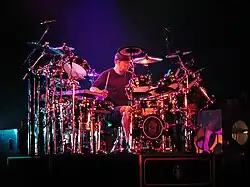
Peart was born in Hamilton, Ontario, and grew up in Port Dalhousie (now part of St. Catharines). During adolescence, he floated between regional bands in pursuit of a career as a full-time drummer. After a discouraging stint in England, Peart returned home to concentrate on music where he joined Rush, a Toronto band, in mid-1974, six years after its formation. Together they released 19 studio albums, with 10 exceeding a million copies sold in the United States. Billboard lists the band third in "most consecutive gold or platinum albums by a rock band".
Early in his career, Peart's performance style was deeply rooted in hard rock. He drew most of his inspiration from drummers such as Keith Moon, Ginger Baker, and John Bonham, players who at the time were at the forefront of the British hard rock scene. As time passed, he began to emulate jazz and big band musicians Gene Krupa and Buddy Rich. In 1994, Peart became a friend and pupil of jazz instructor Freddie Gruber. It was during this time that Peart revamped his playing style by incorporating jazz and swing components.
In addition to serving as Rush's primary lyricist, Peart published several memoirs about his travels. His lyrics for Rush addressed universal themes and diverse subjects including science fiction, fantasy, and philosophy, as well as secular, humanitarian, and libertarian themes. Peart wrote a total of seven non-fiction books focused on his travels and personal stories. He also co-authored with Kevin J. Anderson three steampunk fantasy novels based on Rush's final album, Clockwork Angels. The two also wrote a dark fantasy novella, Drumbeats, inspired by Peart's travels in Africa. (Full article...)
Selected album
Arthur (Or the Decline and Fall of the British Empire), often referred to simply as Arthur, is the seventh studio album by the English rock band the Kinks, released on 10 October 1969. It was the first Kinks album to feature bassist John Dalton, who replaced Pete Quaife after the latter's departure. Kinks frontman Ray Davies constructed the concept album as the soundtrack to a Granada Television play and developed the storyline with novelist Julian Mitchell; the television programme was never produced. The rough plot revolved around Arthur Morgan, a carpet-layer, who was based on Ray and guitarist Dave Davies' brother-in-law Arthur Anning. A stereo version was released internationally with a mono version being released in the UK, but not in the US.
The album was met with poor sales but nearly unanimous acclaim, especially among the American music press. Although Arthur and its first two singles, "Drivin'" and "Shangri-La", failed to chart in the UK, the Kinks returned to the Billboard charts after a two-year absence with "Victoria", the lead single in the US, peaking at number 62. The album itself reached number 105 on the Billboard Top LPs chart, their highest position for three years. Arthur paved the way for the further success of the Kinks' 1970 comeback album Lola Versus Powerman and the Moneygoround, Part One. (Full article...)
Selected song
"Strawberry Fields Forever" is a song by the English rock band the Beatles, written by John Lennon and credited to Lennon–McCartney. It was released on 13 February 1967 as a double A-side single with "Penny Lane". It represented a departure from the group's previous singles and a novel listening experience for the contemporary pop audience. While the song initially divided and confused music critics and the group's fans, it proved highly influential on the emerging psychedelic genre. Its accompanying promotional film is similarly recognised as a pioneering work in the medium of music video.
Lennon based the song on his childhood memories of playing in the garden of Strawberry Field, a Salvation Army children's home in Liverpool. Starting in November 1966, the band spent 45 hours in the studio, spread over five weeks, creating three versions of the track. The final recording combined two of those versions, which were entirely different in tempo, mood and musical key. It features reverse-recorded instrumentation, Mellotron flute sounds, an Indian swarmandal, and a fade-out/fade-in coda, as well as a cello and brass arrangement by producer George Martin. For the promotional film, the band used experimental techniques such as reverse effects, jump-cuts and superimposition.
The song was the first track the Beatles recorded after completing Revolver and was intended for inclusion on their forthcoming (as yet untitled) Sgt. Pepper's Lonely Hearts Club Band. Instead, under pressure from their record company and management for new product, the group were forced to issue it as a single and they followed their usual practice of not including previously released singles on their albums. The double A-side peaked at number 2 on the Record Retailer chart, breaking the band's four-year run of chart-topping singles in the UK. In the United States, "Strawberry Fields Forever" peaked at number 8 on the Billboard Hot 100. The song was later included on the US Magical Mystery Tour LP.
Lennon viewed "Strawberry Fields Forever" as his finest work with the Beatles. After Lennon's murder in New York City, a section of Central Park was named after the song. In 1996, the discarded first version of the song was issued on the outtakes compilation Anthology 2; in 2006, a new version was created for the remix album Love. Artists who have covered the song include Richie Havens, Todd Rundgren, Peter Gabriel, Ben Harper, and Los Fabulosos Cadillacs featuring Debbie Harry. In 1990, a version by the Madchester group Candy Flip became a top-ten hit in the UK and Ireland. The song was ranked number 7 on Rolling Stone's updated 2021 list of "The 500 Greatest Songs of All Time". (Full article...)
Selected picture

Juliette Lewis of Juliette and the Licks at the Eurockéennes of 2007.
Did you know (auto-generated)

- ... that before charting on the UK Albums Chart with Are We There Yet?, the indie rock musician James Marriott had made a career of mocking other YouTubers' music?
- ... that Desulfovibrio vulgaris can remove toxic heavy metals from the environment?
- ... that the British rock musician Hannah Grae went viral online with an anti-sexual harassment parody of Aqua's "Barbie Girl"?
- ... that raw material waste from the West influenced a generation of rock music in China?
- ... that heavy metal led Ossian D'Ambrosio to druidism?
- ... that Canadian punk rock musician Talli Osborne had only briefly spoken to the frontman of NOFX before the band wrote a song about her?
Selected genre
Industrial metal is the fusion of heavy metal and industrial music, typically employing repeating metal guitar riffs, sampling, synthesizer or sequencer lines, and distorted vocals. Prominent industrial metal acts include Ministry, Nine Inch Nails, Fear Factory, Rammstein, KMFDM, and Godflesh.
Industrial metal developed in the late 1980s, as industrial and metal began to fuse into a common genre. Industrial metal did well in the early 1990s, particularly in North America, with the success of groups such as Nine Inch Nails, but its popularity began to fade in the latter half of the 1990s. (Full article...)
Selected audio
Related portals
WikiProjects
- WikiProject Rock music (Main rock project)
- WikiProject Metal
- WikiProject Black Metal
- WikiProject Alternative music
- WikiProject Punk music
- WikiProject Progressive Rock
- WikiProject Music Directory
Things you can do
Expand: College rock, Electronic rock, Pop rock
Clean Up: Instrumental rock, Rap rock, New wave, Industrial rock, Progressive metal, Southern rock, Folk rock, Funk rock, Space rock
Add Sources: Pagan rock
Join one of the many WikiProjects pertaining to Rock music.
News
No recent news
More articles -
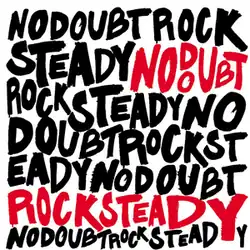
Rock Steady is the fifth studio album by American rock band No Doubt, released on December 11, 2001, by Interscope Records. The band began writing the album with initial recording sessions in Los Angeles and San Francisco, then traveled to London and Jamaica to work with various performers, songwriters, and producers. Sly & Robbie, the Neptunes, and William Orbit were among the many artists the band collaborated with on the album.
As a result of these collaborations, Rock Steady touches on many musical styles, focusing on electropop, dancehall, and new wave. The band attempted to capture the vibe of Jamaican dancehall music, and experimented with writing songs without its standard instrumentation. Lead vocalist Gwen Stefani wrote her lyrics quickly in comparison to previous records, and dealt with topics ranging from partying to ruminations on her relationship with Gavin Rossdale. (Full article...)
More did you know...
- ... that David Bowie's first gig as lead singer was at the Green Man, Blackheath?
- ... that Carlton le Willows Academy alumni include cricketer Mark Footitt, Air Supply singer/guitarist Graham Russell, and balloonist Janet Folkes?
- ... that the video for Marilyn Manson's soft-rock ballad "Running to the Edge of the World" was widely condemned for its depiction of violence against women?
- ... that Susan Beschta was a punk rocker and federal judge?
.jpg)
- ... that the FM Non-Duplication Rule adopted by the FCC 61 years ago led to the creation of the album-oriented and classic rock radio formats?
- ... that The Elvis Dead, a retelling of Evil Dead II in the style of Elvis Presley, features songs such as "Standing in a State of Shock", "I've Been Possessed", and "Wrapped Up in Vines"?
Major topics
Subcategories

Associated Wikimedia
The following Wikimedia Foundation sister projects provide more on this subject:
-
Commons
Free media repository -
Wikibooks
Free textbooks and manuals -
Wikidata
Free knowledge base -
Wikinews
Free-content news -
Wikiquote
Collection of quotations -
Wikisource
Free-content library -
Wikiversity
Free learning tools -
Wikivoyage
Free travel guide -
Wiktionary
Dictionary and thesaurus
-
 List of all portals
List of all portals -

-

-

-

-

-

-

-

-

-
 Random portal
Random portal -
 WikiProject Portals
WikiProject Portals

